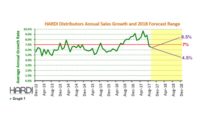Positive Economic Forecast
Duguay provided the attendees with an updated economic forecast for the U.S. economy and for the Southwest Region. He said “Our forecast last year was for the economy to muddle along and grow but at a slower pace and then have a reacceleration trend to happen in the first half of 2012 and then for that growth to continue into 2013. Here we are today and our forecast is the same because we are still on track.” He also shared the ITR Leading Indicator which predicts what will happen to U.S. industrial production which is their benchmark for the economy. The indicator shows an acceleration trend where growth is going to continue to “inch higher.” According to Duguay, “Things are not only looking good, but better heading into the second half of 2012.” He also felt that growth will level off in 2013 and his firm is predicting a mild downturn in 2014.
HARDI distributors in the Southwest have outperformed the rest of country according to ITR reports. April was up 12.6 percent compared to the same month in 2011 and well above the national average of 8.3 percent growth. Over the past 12 months the region was up 7.1 percent compared to 3.5 percent nationally.
Duguay shared that home improvement spending in the U.S. is trending upward. The housing market has declined for four years and recently started to turn upward, but homebuilding will only be at the 650,000 level for 2012 which is substantially lower than the “boom” years when there were 1.2 million to 1.7 million housing starts. Multi-family new construction has grown from 20 percent to 30 percent of the residential market. Duguay predicted that the new construction market would not exceed 1 million starts for at least five years and said, “If you are sitting back waiting for pre-recession levels, that’s just not going to happen.” He also said the commercial construction market would, “Trudge along in 2012 and build up some momentum for 2013.”
Presentation on Evolving Workforce
Malone also introduced the keynote speaker, Marilyn Moats Kennedy whose presentation was titled “Understanding the Demographics of the Evolving Workforce.” Kennedy, author of six books on career planning and organizational politics, pointed out there are five age groups in the workplace and each group has its own unique work values and characteristics that often times come into conflict. The two largest groups, the Baby Boomers born between 1946 and 1959 and the Netsters born between 1979 and 1988, tend to clash the most.
She emphasized that with Boomers work and money come first, they are loyal to the employer, care deeply about what others think, want others to work with them, pay lip service to the company mission, are motivated by money, and they are technically challenged. By contrast, with Netsters lifestyle comes first, they are loyal to their own skills, don’t care what others think, must have a mission, are motivated by time off, and technically they are “state of the art.”
The contrasts between Boomers and Netsters can cause issues if there is a lack of understanding between the two groups. This is even more important in today’s workplace according to Kennedy because 80 percent of Boomers are still working and will continue to work since “work is their hobby” and 20 percent of Boomers have no savings towards retirement. Boomer managers must understand that unlike their own generation, Netsters don’t chat, they are not interested in going to company events, and they work only to support their lifestyle.
Kennedy also provided some insights into recruiting and retaining Netsters in the HVAC industry. Unlike their older counterparts, this age group is interested in making a difference in the environment. An industry and/or company that positions itself as green will appeal to a Netster and a job or career that involves a varied work experience with physical activity is a plus. This is especially true if it focuses on individual physical activity because exercise is very important to younger employees. She said, “Younger workers have an equally powerful work ethic but it is different from the Boomers. It is work to rule, they work hard between 9 and 5 but there is no overtime. When you finish the job you are out the door.”
She also cautioned the Boomer business owners not to expect loyalty from younger workers and they will often leave a company strictly to pursue personal goals and said, “There is no retention there is only recapture.”
Publication date: 8/13/2012







